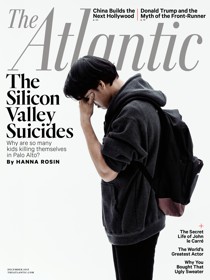Dans les romans, au cinéma, dans les jeux vidéo : la “cli-fi” est désormais partout. Elle permet d’enrôler les jeunes générations dans la lutte contre le réchauffement de la planète.
“La sécheresse ravage le sud-ouest des Etats-Unis. Le Nevada et l’Arizona se disputent les eaux d’un fleuve Colorado de plus en plus exsangue, sous le regard de la Californie qui se demande si elle ne devrait pas faire main basse sur tout le bassin. Quand l’eau est plus précieuse que l’or, les alliances sont aussi mouvantes que le sable et la seule vérité, dans le désert, c’est qu’il faut que quelqu’un meure pour qu’un autre puisse boire.” Le texte ci-dessus a beau ressembler à une présentation quelque peu outrée de la sécheresse qui frappe actuellement l’ouest des Etats-Unis, ce scénario est imaginaire, pour le moment du moins. Il provient de la campagne publicitaire pour le [...] link: http://www.theatlantic.com/entertainment/archive/2015/08/climate-fiction-margaret-atwood-literature/400112/
full article IN FRENCH ....AND ENGLISH ......AT:
Climate Fiction: Can Books Save the Planet?
A new literary genre that focuses on the consequences of environmental issues is striking a chord with younger generations—and engaging them in thinking about the Earth’s sustainability.

The American Southwest has been decimated by drought. Nevada and Arizona skirmish over dwindling shares of the Colorado River, while California watches, deciding if it should just take the whole river all for itself. But when water is more valuable than gold, alliances shift like sand, and the only truth in the desert is that someone will have to bleed if anyone hopes to drink.Although the above might read like a slightly dramatic spin on the Western U.S. drought crisis, this scenario—at least for now—is imaginary. It’s the teaser for Paolo Bacigalupi’s new novel The Water Knife, another recent addition to the rapidly growing canon of climate fiction. Often called “cli-fi,” the genre, in short, explores the potential, drastic consequences of climate change.
It’s not an entirely new concept—Jules Verne played with the idea in a few of his novels in the 1880s—but the theme of man-made change doesn’t appear in literature until well into the 20th century. The British author J.G. Ballard pioneered the environmental apocalypse narrative in books such as The Wind from Nowhere starting in the 1960s. But as public awareness of climate change increased, so did the popularity of these themes: Searching for the term “climate fiction” on Amazon today returns over 1,300 results.
Since the turn of the millennium, cli-fi has evolved from a subgenre of science fiction into a class of its own. Unlike traditional sci-fi, its stories seldom focus on imaginary technologies or faraway planets. Instead the pivotal themes are all about Earth, examining the impact of pollution, rising sea levels, and global warming on human civilization. And the genre’s growing presence in college curriculums, as well as its ability to bridge science with the humanities and activism, is making environmental issues more accessible to young readers—proving literature to be a surprisingly valuable tool in collective efforts to address global warming.
The writer and climate activist Dan Bloom came up with the term “cli-fi” circa 2007, hoping to convert the dull phrase “climate fiction” into something more compelling. “I never defined or even tried to define a new genre,” said Bloom. Instead, he merely wanted to come up with a catchy buzzword to raise awareness about global warming.” The strategy worked: When Atwood used the term in a 2012 tweet, she introduced it to her 500,000 followers, according to Bloom. As the notion of cli-fi took hold, publishers and book reviewers began regarding it as a new category. In this respect, cli-fi is a truly modern literary phenomenon: born as a meme and raised into a distinct genre by the power of social media. Today cli-fi has an actively used hashtag on Twitter, two user-created book lists on Goodreads, and several Facebook groups, including one devoted exclusively to young-adult climate fiction.
The genre offers more than escapist thrills: It’s becoming a springboard for engaging youth in the sciences. Waning interest in STEM subjects has plagued American academia for years. In 2012 the Programme for International Student Assessment found the United States ranked 20th out of 34 countries evaluated for student performance in the sciences. But colleges in the U.S. and abroad—from the University of Oregon to Cambridge University’s Institute of Continuing Education—now offer courses in cli-fi. Earlier this year, students in a cli-fi class at Holyoke extracted DNA from strawberries to understand the genetic engineering themes of Bacigalupi’s award-winning novel The Windup Girl (2009). At Temple University, participants in the cli-fi course used their class blog to share links to science news and cited scientific articles in their book reviews. One student majoring in English admitted on the blog that “when it comes to understanding jargon specific terminology and scientific-based language I get lost and often feel stupid.” The same student went on to post a detailed review of Atwood’s Year of the Flood (2009), examining how climate change would impact various agricultural sectors and describing the chemistry involved.
This fusion of science and the humanities can have practical consequences, encouraging more serious study of STEM, which can intimidate students. With literature and creative writing as a comfortable gateway, “science would become accessible to students who think they aren’t interested in science,” said Ellen Szabo, the author of Saving the World One Word at a Time: Writing Cli-Fi. Szabo’s book discusses the genre’s ability to make environmental issues less political and more personal: Making climate change seem like less of a clinical topic can eventually engender real action. Ted Howell, who teaches the cli-fi class at Temple University, noted that the traditional means of conveying the severity of climate change weren’t effective with his students. “Once they grasped the basic outlines of the issue, they didn’t want to keep reading about 2 percent increases or 4 percent increases in global temperature—they wanted to know what they could do in response,” Howell said.
Not everyone is convinced of cli-fi’s potential. Last year in an opinion piece for The New York Times, George Marshall—the founder of the Climate Outreach Information Network—expressed concern that cli-fi would reinforce what people already believe rather than change anyone’s minds. “The unconvinced will see these stories as proof that this issue is a fiction, exaggerated for dramatic effect,” he said. “The already convinced will be engaged, but overblown apocalyptic story lines may distance them from the issue of climate change or even objectify the problem.”
The Tyndall Centre study also indicated that placing climate change in a fictional context might reduce the urgency readers feel about the issue in reality, or simply reduce it to a vague concern with no practical remedy. Students in the Temple University class felt a twinge of this, too. “Faced with the realization that a truly adequate response to climate change will necessarily involve significant changes to our lifestyle, and sacrifices by those with money, power, and influence, we often grew despondent,” Howell said. Despondent, but not hopeless: He noted that uncertainty also helps emphasize the vast possibilities for reform.
Therein lies the challenge. “Science doesn't tell us what we should do,” Kingsolver wrote in Flight Behavior. “It only tells us what is.” Stories can never be a solution in themselves, but they have the capacity to inspire action, which is perhaps why cli-fi’s appeal among young adult readers holds such promise. As the scientists and leaders of tomorrow, they may be most capable of addressing climate issues where previous generations have failed. Cli-fi, like the science behind it, often presents bleak visions of the future, but within such frightening prophecies lies the real possibility that it’s not too late to steer in a different direction. As Atwood wrote in MaddAddam, “People need such stories, because however dark, a darkness with voices in it is better than a silent void.”
http://www.theatlantic.com/entertainment/archive/2015/08/climate-fiction-margaret-atwood-literature/400112/
http://www.courrierinternational.com/article/climat-et-si-de-la-science-fiction-venait-le-salut

Dans les romans, au cinéma, dans les jeux vidéo : la “cli-fi” est désormais partout. Elle permet d’enrôler les jeunes générations dans la lutte contre le réchauffement de la planète.


1 comment:
http://www.theatlantic.com/entertainment/archive/2015/08/climate-fiction-margaret-atwood-literature/400112/
Post a Comment